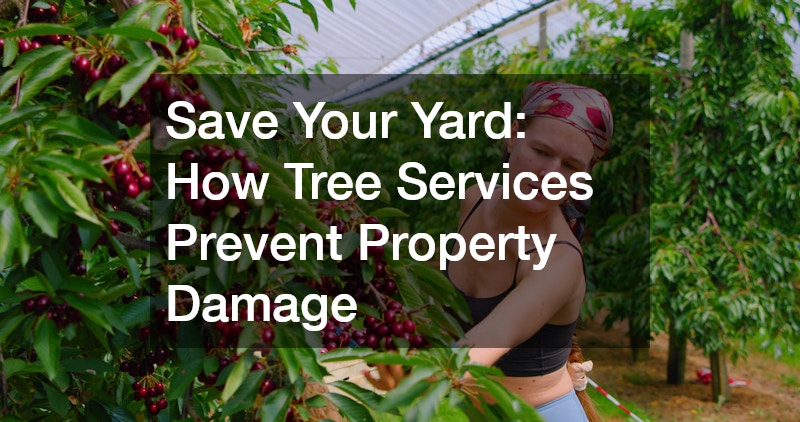Understanding how professional tree services can play a crucial role in maintaining the safety and beauty of your property is key. This article explores common questions about how these services prevent various types of property damage. Whether it’s mitigating risks of fallen branches or managing pests, tree services are fundamental to preserving your property’s integrity.
Routine tree care is essential to ensuring the health of your trees and safety of your property. Professional arborists provide crucial maintenance that prevents small issues from evolving into costly, significant problems.
Regular maintenance isn’t merely an aesthetic concern; it’s a way to protect both your home and your wallet from unexpected disasters.
Preventing Overgrowth and Its Consequences
Overgrowth in trees can lead to numerous issues that threaten property safety and functionality. Regular trimming and pruning prevent tree overgrowth, which can lead to blocked sunlight, power line interference, and increased storm damage risk. When sunlight is obstructed, it can affect plant growth underneath and create damp environments conducive to mold.
In areas prone to strong winds and storms, overgrown trees are more likely to suffer damage, which can become a hazard to surrounding structures. Branches weighted down by excess foliage can break and cause damage to roofs, vehicles, and other structures below. Preventing overgrowth is a proactive step in mitigating such risks before they manifest into more serious concerns.
Tree services provide structured pruning schedules tailored to the specific species and condition of trees. Along with managing growth, this ensures trees maintain a healthy structure, allowing them to better withstand adverse weather conditions. Professionals also ensure that tree trimming is conducted safely, minimizing the danger to both the trees and nearby property.
Avoiding Damage from Fallen Branches
The potential for branch failure is a significant concern for property owners, as fallen branches can cause extensive damage to homes and vehicles. Professional assessments and removal of weak branches can prevent costly damage. When branches show signs of disease, pest infestation, or structural weakness, it is crucial to address them promptly.
Arborists employ a variety of techniques to assess a tree’s health and stability, allowing them to make informed decisions about necessary pruning or removal. This assessment includes evaluating the overall condition of branches, examining them for signs of decay or infestation. Such preventative action is essential in maintaining the health of the tree and the safety of the surroundings.
Removing problematic branches not only prevents immediate risks but also promotes the tree’s health. This selective pruning encourages robust growth by diverting nutrients and boosting the tree’s resilience against future stressors. Homeowners that partner with professional tree services enjoy peace of mind knowing their properties are safe and well-maintained.
Identifying Hazardous Trees
One of the essential aspects of tree service is identifying and mitigating hazardous trees before they pose a risk. Professionals use their expertise to identify trees that pose a safety hazard, and recommend appropriate actions to mitigate risks. This preemptive action involves thorough inspections and understanding tree biology and environmental interactions.
Hazardous trees may exhibit signs such as leaning structures, root damage, or significant deadwood. By evaluating these indicators, arborists can develop a plan to either improve the tree’s condition or safely remove it if necessary. Such strategies can prevent accidents, saving homeowners stress, money, and potential injury.
Recognizing and managing tree hazards is not only about preventing damage but also about ensuring trees thrive in harmony with their environment. Regular assessments help maintain the balance between safety and aesthetics, allowing properties to benefit from both. This proactive approach ensures safety without compromising the visual appeal that trees offer a landscape.
Increased Property Value
Well-maintained trees significantly enhance the visual appeal and overall value of a property. Trees are a crucial part of landscaping that is often considered in property appraisals, reflecting on the home’s worth. See how well-maintained trees contribute to the aesthetic appeal and increased value of your property.
Mature, healthy trees create inviting and pleasant environments, which can attract potential buyers, making properties more marketable. In addition to beauty, properly cared-for trees indicate a responsible homeowner, willing to invest in maintaining their property. This notion can positively influence buyers and potentially raise property sale values.
Trees can also improve a neighborhood’s overall appeal, adding value to surrounding properties and contributing to community desirability. The presence of healthy trees is linked to increased shade, privacy, and a general sense of harmony within neighborhoods. These factors play a significant role in property and community value over time.
Longevity of Trees
The longevity of a tree significantly influences its benefits to a property and the environment. Understand how professional care ensures the health and longevity of your trees, providing benefits for years to come. Long-lived trees offer extended shading, beauty, and ecosystem contributions.

